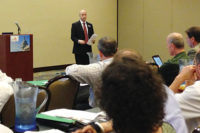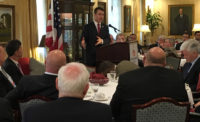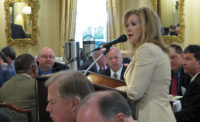WASHINGTON — Representatives from many of the industry’s manufacturers recently congregated in Washington, D.C., for two days of networking, lobbying, and discussing industry issues at this year’s annual Air-Conditioning, Heating & Refrigeration Institute (AHRI) Public Policy Symposium.
Attendees met with legislators and shared their thoughts and concerns on many topics, including regional standards legislation, Congression-al gridlock, tax incentives, climate change, energy efficiency, and regulatory burden on the industry.
Regional Standards
The ongoing regional standards lawsuit proved to be a hot-button issue at the symposium, popping up repeatedly during presentations and in conversations and discussions. As this issue went to print, the court had yet to accept the settlement agreement that would eliminate the May 1 implementation date on which 90 percent AFUE nonweatherized furnaces would be mandated in the North.
“That lawsuit’s been going on over the past year,” said David Calabrese, senior vice president of policy for AHRI. “Late last year, DOE (U.S. Department of Energy) and APGA (American Public Gas Association) agreed to a settlement for a vacatur of the furnace standards and a remand, essentially erasing the furnace standards that will take effect May 1 and then remanding them back to DOE for a rulemaking.”
If the court accepts the settlement agreement between the DOE and the APGA, new furnace standards likely would not go into effect until 2019 or later.
On March 19, AHRI filed a motion to delay the implementation date for furnace minimum-efficiency standards while the court continues to mull over the settlement agreement. Calabrese said AHRI also recently asked the DOE “to voluntarily stay or delay the effective date, and they refused.” He added, “They won’t respond to us.”
Meanwhile, contractors, distributors, and manufacturers continue to hang in limbo waiting for a definitive resolution, unsure of how to proceed amidst the uncertainty.
“Right now, as things stand, while we have two years for the air conditioner standard to take effect, the furnace standard is still on the books to take effect on May 1, 2013. At this point, we have no word on how the court, or when the court, will rule,” Calabrese said. “In this industry, that’s a real problem, a real concern. Nobody knows what to do.”
Energy Efficiency
Two panel discussions on energy policy and regulatory environment gave symposium attendees a chance to hear the latest policy news and interact directly with lawmakers. Discussions ranged from climate change to energy efficiency standards and sequestration.
The Energy Savings and Industrial Competitiveness Act, introduced nearly two years ago by Sens. Jeanne Shaheen, D-N.H. and Rob Portman, R-Ohio, garnered plenty of attention during panel discussions. The bipartisan Shaheen-Portman bill focuses on saving money by increasing industrial and federal agency energy efficiency nationwide.
“Energy efficiency seems to be something everybody really likes, something everybody can get behind,” said Heath Knakmuhs, senior director of policy at the U.S. Chamber of Commerce’s Institute for 21st Century Energy. “The Shaheen-Portman bill is obviously a key centerpiece of that movement.”
Energy-saving performance contracts, Knakmuhs added, are becoming especially popular. “It’s a great way for the government to increase its energy efficiency without any out-of-pocket costs. Obviously, in Washington, we’re in a very budget-conscious environment.”
Knakmuhs said any legislation presented on Capitol Hill that requires spending stands a low chance of passing, which is why money-saving energy-efficiency legislation is so popular. It also offers an opportunity for manufacturers.
“You can all be beneficiaries of that, supplying the equipment and know-how to enhance energy efficiency in government buildings,” he said.
Calabrese said the bill could prove to be beneficial for manufacturers. “There’s some good stuff in it,” he said. “I think it has some positive value, and if there’s going to be any energy bill passing, I think that’s probably it.” Calabrese added that the bill may open the door to other legislation that may be beneficial to the industry, including bonus depreciation.
Knakmuhs urged attendees to support the bill. “All of you should remain involved in it,” he said. “I think it’s worthy of your time.”
Climate change also took center stage briefly during the panel discussions. Jeff Baran, counsel for the U.S. House of Representatives Committee on Energy and Commerce, said climate change and energy efficiency are closely related.
“We primarily look at energy efficiency through the eyes of climate change,” Baran said. “It’s an essential part of any serious effort to address climate change, and it’s the low-hanging fruit that reduces pollution while saving people money.”
Baran added that improving energy efficiency helps buy more time to address climate change in the U.S. “It’s a threat that is not going away,” he said, “and the window for effective action on climate change is closing.”
Regulatory Burden
The most widely discussed issue at the symposium, and the predominant theme of the conference, was the increasing amount of regulation placed on industry products and the undue burden many believe this is placing on manufacturers. Karim Amrane, regulatory and research vice president, AHRI, pointed out that, just this year, new rulemaking initiatives have included minimum-efficiency standards for commercial and industrial pumps, residential boilers, some rooftop units, packaged terminal equipment, and residential water heaters.
During one of the panel discussions, one AHRI member suggested taking the regulatory burden away from manufacturers, saying the industry “has been one of the most responsive groups in the world for energy efficiency with the things we’ve done with our products, mostly through competition and self-regulation.”
In response to the suggestion, panel member Patrick Currier, counsel for the U.S. House of Representatives Committee on Energy and Commerce, admitted that government overregulation of industry products can be, and has been, detrimental to manufacturers.
“I think we would agree that federal standards make sense when they’re meant to rectify market failures. However, when you start seeing the wrenching-up, the tightening of these standards, it can become incredibly cumbersome and difficult for manufacturers to meet those,” Currier said. “What you do then is make the manufacturing process more difficult and more challenging and drive up the price of the product. So, I think we have to be very careful.”
Rep. Randy Weber, R-Texas, one of half a dozen Congressmen who spoke to AHRI members on Capitol Hill, agreed that overregulation is not good for the HVACR industry. “They don’t realize all the rules that they promulgate drive the price up for the consumers,” he said. “We need to unleash industry — they need to get out of the way and let the industry do its job.”
Amrane, who spoke during a media roundtable event preceding the symposium, said increasing regulatory legislation governing industry products also includes a new trend that could present new challenges to some manufacturers.
“The thing to take out of this is that the DOE is now looking at components — pumps, fans, blowers, and compressors,” Amrane said. “It is true the DOE was given the authority to regulate those components a long time ago, but they never decided to before now. However, someone at DOE feels there is a need to go after those components.”
Amrane said that components in existing products that are already regulated will not be affected, though “there are several component products that AHRI members make that will be regulated by these DOE rules.”
He finished, stating, “It’s something to keep in mind.”
But, manufacturing members agree, simply keeping these issues in mind is not enough. Cooperation between AHRI, other organizations, and the government is the key to easing regulatory burden on the industry, said Al Stayman, professional staff member, Senate Committee on Energy and Natural Resources.
“It’s becoming more and more difficult to get people together into a room to negotiate these solutions and then have the proper solution approved by Congress,” Stayman said, “Obviously, having the full support of an organization like AHRI, which communicates so much to Congress that is worthy of its consideration, is important. We want this program itself to be as efficient as possible.”
AHRI Looks Ahead
In addition to pursuing solutions to the regional standards lawsuit and regulatory burden, AHRI leaders discussed several issues affecting its members, including Congressional gridlock and industry tax incentives.
Jim Walters, vice president of international affairs, AHRI, lamented the scaling-back of the 25C residential energy-efficiency tax credit. “When the stimulus bill was passed, we had $1,500 limits with higher caps, and it was real money taxpayers could use for high-efficiency furnaces, air conditioners, boilers, and water heaters,” he said. “Now, it’s a $500 lifetime cap.”
The reduction, Walters said, has negatively impacted contractors, distributors, and manufacturers, who have not promoted the reduced credit since it was retroactively reinstated on Jan. 1. “From AHRI’s standpoint, we are looking for opportunities to fix it, to increase it, but in the environment we’re in, with the sequester and the deficit, I think it’s very unlikely there will be any change with it.”
AHRI is also targeting section 179D of the Energy Policy Act of 2005. “That’s a formula for a tax credit; it looks at the entire building and the efficiency of it,” Walters said. “The way the formula is written now is not very effective, and the lighting manufacturers have found it more beneficial than we have. We want to make it more effective for our industry and our businesses.”
But getting its agenda through to Congress in the current volatile political environment won’t be easy for AHRI. “Mark Twain said the opposite of progress is Congress,” Weber said, drawing chuckles from symposium attendees. Weber, who founded his own HVAC company more than 30 years ago, acknowledged that getting through to Congress is no easy task.
“None of us wake up in the morning and think, now how can I make the air and the water dirtier for our kids and grandkids? We all want to create a clean environment, create a great product, and have the American people comfortable with us and our products, and we understand that in Texas,” Weber said. “I would like to see Congress pass some rules and regulations.”
In the meantime, AHRI will continue to navigate the rocky political waters in order to advocate for its members in the U.S. and beyond. “Things are different than they were, and they’re going to be different tomorrow,” Walters said. “The biggest challenge we face is to change the paradigm by which we think about how we do our business, how we go about accounting for energy efficiency, and, therefore, how we all regulate it, because we will be regulating it.”
Publication date: 4/29/2013












